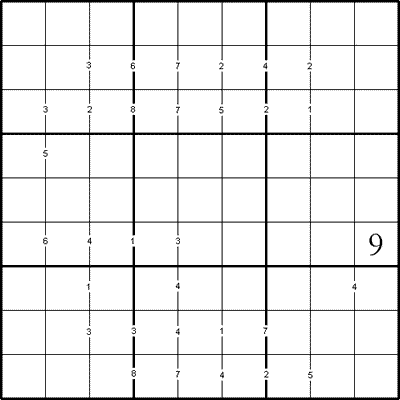Skip over navigation

Or search by topic
Number and algebra
Geometry and measure
Probability and statistics
Working mathematically
Advanced mathematics
For younger learners
Pole Star Sudoku
Age 14 to 18
Challenge Level 





- Problem
- Student Solutions
by Henry Kwok

These are small numbers placed always on the border lines between selected pairs of neighbouring cells of the grid.
Each clue-number is the difference between the two numbers that should be in the neighbouring cells just to the left and to the right from that clue-number. For example, a clue-number 7 on the border line means that one of the possible answers in the cell on the left can be 9, 2, 8 or 1. If we choose 9 for the answer in the cell, it means that the answer in the cell next to it on the right is 2. If we choose the answer 2, it means that the answer on the right is 9.
Not much information is there? However, fortunately for the solver, you can use a starting digit (digit 9 in the last column) as the Pole Star to guide you out of the "wilderness" of the puzzle.
Hence this Sudoku variant is named Pole Star Sudoku.
The remaining rules are as in a standard Sudoku: the object of the puzzle is to fill in the whole 9x9 grid with numbers 1 through 9 (one number per cell) so that each horizontal line, each vertical line, and each of the nine 3x3 squares (outlined with the bold lines) must contain all the nine different numbers 1 through 9.
An article about this type of Sudoku can be found here .

Rules of Pole Star Sudoku
This is a variation of Sudoku on a standard 9x9 grid which contains a set of special clue-numbers.These are small numbers placed always on the border lines between selected pairs of neighbouring cells of the grid.
Each clue-number is the difference between the two numbers that should be in the neighbouring cells just to the left and to the right from that clue-number. For example, a clue-number 7 on the border line means that one of the possible answers in the cell on the left can be 9, 2, 8 or 1. If we choose 9 for the answer in the cell, it means that the answer in the cell next to it on the right is 2. If we choose the answer 2, it means that the answer on the right is 9.
Not much information is there? However, fortunately for the solver, you can use a starting digit (digit 9 in the last column) as the Pole Star to guide you out of the "wilderness" of the puzzle.
Hence this Sudoku variant is named Pole Star Sudoku.
The remaining rules are as in a standard Sudoku: the object of the puzzle is to fill in the whole 9x9 grid with numbers 1 through 9 (one number per cell) so that each horizontal line, each vertical line, and each of the nine 3x3 squares (outlined with the bold lines) must contain all the nine different numbers 1 through 9.
An article about this type of Sudoku can be found here .
You may also like
Instant Insanity
Given the nets of 4 cubes with the faces coloured in 4 colours, build a tower so that on each vertical wall no colour is repeated, that is all 4 colours appear.

